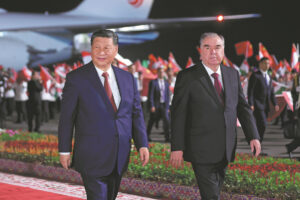The foreign ministers of more than 20 countries, including the ten ASEAN members, China, the US, Russia, Japan and India, attended the 56th ASEAN Foreign Ministers’ Meeting and Post Ministerial Conference (AMM-PMC) in Jakarta, Indonesia in July this year. During the meetings, US Secretary of State Blinken’s attempt to challenge China and instigate a group opposition against it was met with little response, which revealed a sharp contrast between America’s all-out efforts to contain China and the regional countries’ refusal to take sides. As Indonesian President Joko said in his speech, Southeast Asia is not an arena for major countries, nor is ASEAN a proxy for any other country.
Its nature and fundamental purpose to contain China and maintain America’s dominance in the Asia Pacific has exposed the “Indo-Pacific strategy” to constant doubts, vigilance and criticism from countries in the region ever since it was put forward. This demonstrated that America’s practice of strengthening alliances and forming confrontational blocs goes counter to the “Asian approach” characterized by consultation, openness, and inclusiveness; America’s attempt to delink the regional countries from China goes counter to the development philosophy of improving interconnectivity and prioritizing regional cooperation upheld by countries in Asia Pacific; and America’s hype of security threats and war risks goes counter to the region’s demand for enhanced governance of non-traditional security issues.
Unlike Japan, Australia and other US allies that support and follow the Indo-Pacific strategy, Southeast Asian countries have maintained strategic prudence, held their position and adopted independent strategic measures in response to the series of moves that Washington has taken under the framework of that strategy – creating new geopolitical concepts, controlling the so-called rules-making power, activating and forming new regional mechanisms, and hyping up and sticking its nose into regional security issues.
US control of rules-making power
The US used the “Indo-Pacific”concept to replace “Asia Pacific” to expand the networked security architecture under its lead. However, ASEAN used this concept in a selective way. On the one hand, it hopes to highlight its central position in the vast region involving the Pacific Ocean and the Indian Ocean; on the other hand, being fully aware of America’s strategic intention, it has reiterated that the ASEAN version of “Indo-Pacific” is a more inclusive concept rather than the indiscriminate acceptance of what America feeds them.
Establishing a strategy requires the formulation and implementation of a series of rules and norms. In this regard, preserving the “rules-based regional order” has been an old trick played by the US, which in essence is just the US making the rules, claiming itself to be the protector of those rules, and then slandering China as the one breaking them.
Most ASEAN countries share China’s position to handle the South China issue in accordance with international law, including the United Nations Convention on the Law of the Sea (UNCLOS), rather than take the so-called South China Sea arbitration award as the fundamental legal basis. In fact, all the collective ASEAN statements have upheld the principle of not mentioning the arbitration award when it comes to the South China Sea issue.
More importantly, ASEAN and China have reached a consensus to implement the Declarationon the Conduct of Parties in the South China Sea (DOC) and push forward the negotiation on the Code of Conduct (COC) in the South China Sea. In 2022, the 20th anniversary of the signing of DOC, the two sides issued a joint statement that affirmed the document’s great significance in keeping the regional situation stable. At the latest AMM-PMC, China and ASEAN countries completed the second reading of the Single Draft Negotiating Text (SDNT) of the COC, which fully demonstrated their common political wish to make progress on the COC negotiation.
A more strategically independent ASEAN in the face of US interference
Establishing regional mechanisms, including strengthening bilateral military alliances, activating the US-Japan-India-Australia Quad security dialogue, and forming the US-UK-Australia trilateral security partnership, is an important way for the US to implement its “Indo-Pacific strategy”. These maneuvers have largely shaken the regional security architecture and undermined ASEAN’s “unity” and position.
Although the Biden administration has repeatedly stressed how the Quad and AUKUS are “complementary” with ASEAN in the regional landscape, most Southeast Asian countries are cynical about America’s commitment to supporting ASEAN’s central position. Leaders of Indonesia and Malaysia have publicly condemned the AUKUS for creating the potential risk of regional nuclear proliferation.
Since 2022, ASEAN, striving to reshape its strategic independence, has made special efforts to push the implementation of the ASEAN Outlook on Indo-Pacific (AOIP) in a bid to set the agenda for regional cooperation and enable a more inclusive and open international community.
In the meantime, ASEAN underscores the importance of taking the UN Charter and the Treaty of Amity and Cooperation in Southeast Asia (TAC) as the regional norms that should be observed by all parties. It also reiterated its commitment to the principlesof non-alignment in the “JOINT COMMUNIQUÉ OF THE 56th ASEAN FOREIGN MINISTERS’ MEETING”, posing a sharp contrast to America’s alliance system.
Maintaining strategic sobriety against geopolitical game
The US has kept fleshing up its “Indo-Pacific strategy” with a view to realizing all-round containment of China. For one thing, it keeps hyping up and meddling in regional security issues to augment regional countries’ strategic anxiety. For another, it tries to link economic and technological subjects with “security”, not only throwing out the “Indo-Pacific economic framework” excluding China, but also setting rules deliberately meant to keep it out.
Regional countries have retained a high level of strategic sobriety regarding America’s intentions to mislead and derail their cooperation agenda. When a new round of crisis occurred in the Taiwan strait in August 2022, ASEAN issued a joint statement at the first opportunity announcing their position to bolster the one-China principle, while Southeast Asian and South Pacific countries such as Indonesia, Malaysia and Fiji also declared their positions at the Shangri-La Dialogue, ASEAN Regional Forum and other regional platforms. In comparison with the so-called major-country competition, the rising sea level, food shortage, energy shortage, cross-border crimes, and public health and security are real threats concerning the social stability, economic development, and even the very survival of countries in the region.
Most of these countries are worried that the “delinking” and “de-risking” theories peddled by the US will sabotage the existing economic collaboration and hinder global sci-tech progress. What they want to see is a multi-polar, open international environment. All these reflect the developing countries’ strong wish to enhance their strategic independence, which is bound to exert profound effects on the global order, including the Asian Pacific region.
(Zhang Jie, invited researcher at the Center for Xi Jinping Thought on Socialism with Chinese Characteristics for a New Era, CASS)
Source : eng.chinamil.com.cn











